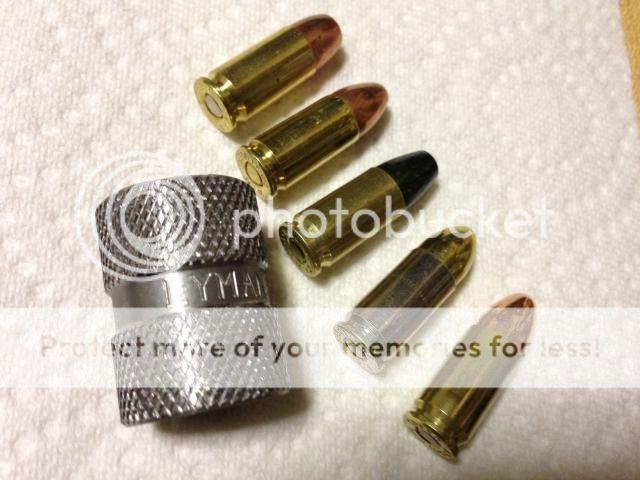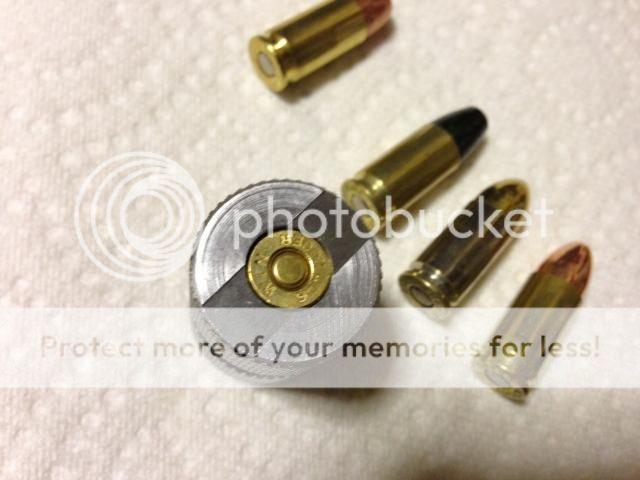Cheesewhiz
Hunter
I use case gages for my semi-auto rounds that I reload, I don't check every round coming off the press with them. I run a progressive press and that would really slow me down but I check the first few and spot check at intervals.
I have my dies indexed and locked with the Hornady quick change set-up so change over gets me were I need to be pretty much right away. I even have a lower end for my powder drop so I don't even have to adjust for that height being correct to case length. I of course do a step by step check through my process and run a few dummies just to assure I have things right. My FCD has index marks that I put on it so my adjustment for diameter of any given bullet and any other variables are pretty much locked in. I can change over from 9mm to .45 ACP in about twenty minutes using this system, sometimes getting the powder just right can be a real brain jammer but it comes along normally well enough.
...But this is about case gages.
I've been using them for quite a while I had more expensive ones but they just got beat up and the Lymans I use now do a fine job and only cost about $15 with free Amazon prime shipping.
I'm posting some pics that I found interesting and references some things I've been talking about the last few years. The Lyman gage is a max gage, it will show the max full length diameter, in the case of a 9mm, the designed taper of the case itself, needed to pass as just slightly less than max (max is sticky in the gage). It also checks for proper head space case length and the check is right on the money with a stated .005" under variable being okay for use in a pistol. there is also a couple of other check points that are built in but I check those things with other devices that I find more likely variables that need monitoring.
Here is a pic of the gage and five 9mm rounds. The top round is a factory Remington range pick up laying on a bench, the second one down is a factory Winchester WWB from a 100 round pack that my friend had issues with in his Sig and gave them to me to check out. The middle one is one of my reloads, a Bayou coated Hardcast 147gr FN, next is a another reload using Montana Gold 124gr FMJ bullet in a nickel case, I use a nickel case to keep track of how many times a batch of cases as been reloaded, this batch has been loaded 25 times +1 and the lowest and last is a newly reloaded Berry's Bullet 124gr double plated 124gr RNHB bullet.

The second pic is one with the Winchester WWB round inserted in the gage, all the rounds passed the slip in test and that gage tolerance is a lot tighter than any barrel chamber pulled from any gun, I can tell you that with complete confidence. If it fits in the gage it should easily chamber in any pistol.

Now the third pic is tough to see well but that same Winchester WWB round failed the headspace test badly, like really badly. It was .017" short of being flush with the top index point, even with that .005" leniency, the case will skip over it headspace point in the chamber and will go into the barrel far too much and the brass will engage the rifling. This is caused because Winchester in it's infinite wisdom, at least that day, decided to roll crimp the rounds, all of the ones found in that box, instead of doing a proper taper crimp. My CZ pistols and all Sigs are known for having an abrupt transition from the chamber to the rifling, the extra length allowed going forward due to the loss of a proper headspacing would cause the brass to engage the rifling and therefore the case mouth would not be able to expand and that would cause a huge pressure spike in an already high pressured round. Glocks would also have an issue as the polygonal rifling forms kind of a star shape at the end of the chamber and the beginning of the rifling, that case would be locked into that shape causing the same over pressure situation.

I thought you guys would find this interesting and I would also encourage anyone the reloads for semi-auto pistols to spend the few extra bucks and get a gage, it will save you problems in the long run and help make you a better reloader.
I have my dies indexed and locked with the Hornady quick change set-up so change over gets me were I need to be pretty much right away. I even have a lower end for my powder drop so I don't even have to adjust for that height being correct to case length. I of course do a step by step check through my process and run a few dummies just to assure I have things right. My FCD has index marks that I put on it so my adjustment for diameter of any given bullet and any other variables are pretty much locked in. I can change over from 9mm to .45 ACP in about twenty minutes using this system, sometimes getting the powder just right can be a real brain jammer but it comes along normally well enough.
...But this is about case gages.
I've been using them for quite a while I had more expensive ones but they just got beat up and the Lymans I use now do a fine job and only cost about $15 with free Amazon prime shipping.
I'm posting some pics that I found interesting and references some things I've been talking about the last few years. The Lyman gage is a max gage, it will show the max full length diameter, in the case of a 9mm, the designed taper of the case itself, needed to pass as just slightly less than max (max is sticky in the gage). It also checks for proper head space case length and the check is right on the money with a stated .005" under variable being okay for use in a pistol. there is also a couple of other check points that are built in but I check those things with other devices that I find more likely variables that need monitoring.
Here is a pic of the gage and five 9mm rounds. The top round is a factory Remington range pick up laying on a bench, the second one down is a factory Winchester WWB from a 100 round pack that my friend had issues with in his Sig and gave them to me to check out. The middle one is one of my reloads, a Bayou coated Hardcast 147gr FN, next is a another reload using Montana Gold 124gr FMJ bullet in a nickel case, I use a nickel case to keep track of how many times a batch of cases as been reloaded, this batch has been loaded 25 times +1 and the lowest and last is a newly reloaded Berry's Bullet 124gr double plated 124gr RNHB bullet.

The second pic is one with the Winchester WWB round inserted in the gage, all the rounds passed the slip in test and that gage tolerance is a lot tighter than any barrel chamber pulled from any gun, I can tell you that with complete confidence. If it fits in the gage it should easily chamber in any pistol.

Now the third pic is tough to see well but that same Winchester WWB round failed the headspace test badly, like really badly. It was .017" short of being flush with the top index point, even with that .005" leniency, the case will skip over it headspace point in the chamber and will go into the barrel far too much and the brass will engage the rifling. This is caused because Winchester in it's infinite wisdom, at least that day, decided to roll crimp the rounds, all of the ones found in that box, instead of doing a proper taper crimp. My CZ pistols and all Sigs are known for having an abrupt transition from the chamber to the rifling, the extra length allowed going forward due to the loss of a proper headspacing would cause the brass to engage the rifling and therefore the case mouth would not be able to expand and that would cause a huge pressure spike in an already high pressured round. Glocks would also have an issue as the polygonal rifling forms kind of a star shape at the end of the chamber and the beginning of the rifling, that case would be locked into that shape causing the same over pressure situation.

I thought you guys would find this interesting and I would also encourage anyone the reloads for semi-auto pistols to spend the few extra bucks and get a gage, it will save you problems in the long run and help make you a better reloader.
